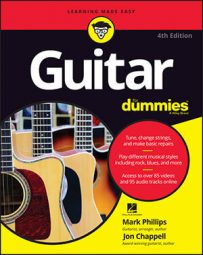How a guitar is built defines what type of guitar it is and (generally) what type of music it's used for. Consider just two examples:
A solid-body electric guitar is used for rock. It has no holes in the body — which adds to its sustain (the guitar's ability to increase the amount of time a plucked note rings).
An acoustic archtop is used for traditional jazz, because it has a carved, contoured top, which produces the mellow tones most associated with that style.
Solid wood versus laminated wood
A solid-wood acoustic guitar is more desirable than a laminated acoustic guitar (where, instead of using a solid, thicker piece of top-wood, the guitar maker uses several layers of inexpensive wood pressed together and covered with a veneer). Guitars made completely out of solid wood are more expensive — costing about $500 or more.
The guitar's top is the most critical element in sound production; the back and sides primarily reflect the sound back through the top. So if you can't pick up the tab for an all-solid-wood acoustic guitar, look to various configurations in which the top is solid and various other parts are laminated. A good choice is a solid-top guitar with laminated back and sides, which is much less expensive than an all-solid-wood model.
If you're unsure as to whether a guitar has solid or laminated wood, ask the dealer or consult the manufacturer.
Body caps
In the electric realm, one big determinant of price is whether the top has a cap. A cap is a decorative layer of fine wood — usually a variety of figured maple (one having a naturally occurring decorative grain pattern) — that sits on top of the body without affecting the sound. Popular cap woods include flame maple and quilted maple. Figured-wood tops usually come with clear, or see-through, finishes to show off the wood's attractive grain pattern.
Neck construction
The following list describes the three most common types of neck construction, from the least expensive to the most expensive:
Bolt-on: The neck attaches to the back of the guitar with large bolts (although a plate sometimes covers the bolt holes). Fender Stratocasters and Telecasters are examples of guitars with bolt-on necks.
Set-in (or glued-in): The neck joins the body with an unbroken surface covering the connection, creating a seamless effect from neck to body. The joint is then glued. Gibson Les Pauls and Paul Reed Smiths have set-in necks.
Neck-through-body: A high-end construction where the neck is one long unit (although usually consisting of several pieces of wood glued together) that doesn't stop at the body but continues all the way through to the tail of the guitar. This type of neck is great for getting maximum sustain. A Jackson Soloist is an example of a guitar with a neck-through-body design.
Just because a construction technique is more advanced or expensive doesn't mean that it's necessarily better than other techniques. Could you "improve" the sound of Jimi Hendrix's Strat by modifying its neck to a glued-in configuration? Sacrilege!

